What to do if my Kohler Portable Generator will not start but cranks okay?
- PpestradaAug 4, 2025
If your Kohler Portable Generator's engine cranks but doesn't start, ensure there's fuel in the tank. If the tank is full, the fuel pump may be defective and needs replacement. Note that the fuel pump is polarity sensitive and will fail if the lead connections are made in reverse.




